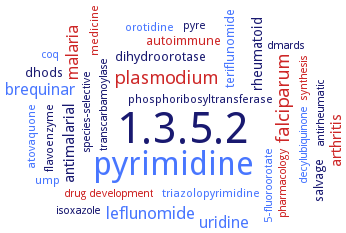1.3.5.2: dihydroorotate dehydrogenase (quinone)
This is an abbreviated version!
For detailed information about dihydroorotate dehydrogenase (quinone), go to the full flat file.

Word Map on EC 1.3.5.2 
-
1.3.5.2
-
pyrimidine
-
falciparum
-
plasmodium
-
leflunomide
-
brequinar
-
uridine
-
malaria
-
arthritis
-
antimalarial
-
rheumatoid
-
dihydroorotase
-
salvage
-
teriflunomide
-
dhods
-
autoimmune
-
orotidine
-
ump
-
atovaquone
-
triazolopyrimidine
-
flavoenzyme
-
medicine
-
phosphoribosyltransferase
-
antirheumatic
-
coq
-
drug development
-
decylubiquinone
-
dmards
-
synthesis
-
species-selective
-
pyre
-
pharmacology
-
isoxazole
-
transcarbamoylase
-
5-fluoroorotate
- 1.3.5.2
- pyrimidine
- falciparum
- plasmodium
- leflunomide
- brequinar
- uridine
- malaria
- arthritis
-
antimalarial
-
rheumatoid
- dihydroorotase
-
salvage
- teriflunomide
-
dhods
- autoimmune
- orotidine
- ump
- atovaquone
- triazolopyrimidine
-
flavoenzyme
- medicine
-
phosphoribosyltransferase
-
antirheumatic
- coq
- drug development
- decylubiquinone
-
dmards
- synthesis
-
species-selective
-
pyre
- pharmacology
-
isoxazole
-
transcarbamoylase
- 5-fluoroorotate
Reaction
Synonyms
class 2 dihydroorotate dehydrogenases, DHO-DH, DHOD, DHODase, DHODH, dihydroorotate dehydrogenase, EC 1.3.99.11, ETH_00004975, hDHODH, HsDHODH, L-5,6-dihydroorotate:ubiquinone exidoreductase, PfDHODH
ECTree
Advanced search results
Crystallization
Crystallization on EC 1.3.5.2 - dihydroorotate dehydrogenase (quinone)
Please wait a moment until all data is loaded. This message will disappear when all data is loaded.
comparison of ligand-free forms of Schistosoma mansoni DHODH and human DHODH, which undergo different rearrangements in solution
in complex with inhibitors (2Z)-N-(biphenyl-4-yl)-2-cyano-3-hydroxybut-2-enamide, (2Z)-N-(3-chloro-2'-methoxybiphenyl-4-yl)-2-cyano-3-hydroxybut-2-enamide, (2Z)-2-cyano-N-(2,2'-dichlorobiphenyl-4-yl)-3-hydroxybut-2-enamide, and (2Z)-2-cyano-N-(3'-ethoxybiphenyl-4-yl)-3-hydroxybut-2-enamide
in complex with inhibitors 2-[(2,5-dichlorophenyl)sulfanyl]-5-methyl[1,2,4]triazolo[1,5-a]pyrimidin-7-ol and 2-[(2,5-dichlorophenyl)sulfanyl]-5-ethyl[1,2,4]triazolo[1,5-a]pyrimidin-7-ol. bindung induces a structural change in the N-terminal helix. Comparison with binding to Plasmodium falciparum enzyme
in complex with inhibitors 6-chloro-2-(2'-fluorobiphenyl-4-yl)quinoline-4-carboxylic acid and and without any bound inhibitor, to 2.3 A, 2.1 A, and 3.0 A resolution, respectively. Inhibitor 5-methoxy-2-[(4-phenoxyphenyl)amino]benzoic acid 5-methoxy-2-[(4-phenoxyphenyl)amino]benzoic acid interacts with residue Y356. Loop region of residues L68-R72 may interfere with inhibitor/cofactor binding. Loop region N212-L224 may be important for the enzymatic reaction
in complex with low molecular weight compounds that inhibit the enzyme in the nanomolar range, by hanging-drop vapor diffusion method, to 2.15 A resolution
purified recombinant enzyme in complex with inhibitors 41 and 43, X-ray diffraction structure determination and analysis
all compounds that were found to be inhibitors are predicted, using SPROUT, a software package for structure-based drug discovery and lead optimization, to bind in a manner similar to that observed for compound (2Z)-N-(biphenyl-4-yl)-2-cyano-3-hydroxybut-2-enamide, with the planar headgroup making direct hydrogen bonds to residues Arg265, His185, and Tyr528. The biphenyl tail of each inhibitor is predicted to bind in the large hydrophobic region of the binding cavity, in a fashion analogous to that found for these inhibitors in human DHODH. The substituted biaryl moiety present in these inhibitors is predicted to occupy the binding cavity more extensively compared to that of compound (2Z)-N-(biphenyl-4-yl)-2-cyano-3-hydroxybut-2-enamide
in complex with inhibitors 5-methyl-N-(naphthalen-2-yl)[1,2,4]triazolo[1,5-a]pyrimidin-7-amine, N-anthracen-2-yl-5-methyl[1,2,4]triazolo[1,5-a]pyrimidin-7-amine, and 5-methyl-N-[4-(trifluoromethyl)phenyl][1,2,4]triazolo[1,5-a]pyrimidin-7-amine to 2.0 A, 2.4 A, and 2.5 A resolution, respectively
purified recombinant His-tagged mutant DHODDELTA384-413 free or in complex with Genz-667348, hanging drop vapour diffusion method, 20°C, mixing reservoir solution A containing 0.16 M ammonium sulfate, 0.1 M sodium acetate, pH 4.4, 14-15% PEG 4000, 25% glycerol, and 10 mM DTT, with an equal volume of 20 mg/ml protein pre-equilibrated with 0.6 mM Genz-667348, and 2 mM dihydroorotate, X-ray diffraction structure determination and analysis at 2.4 A resolution, molecular replacement
homology modeling, presence of an additional protuberant domain predicted to fold as a flexible loop and absent in the other known class 2 DHODHs. The ligand-free forms of Schistosoma mansoni DHODH and human DHODH undergo different rearrangements in solution


 results (
results ( results (
results ( top
top





